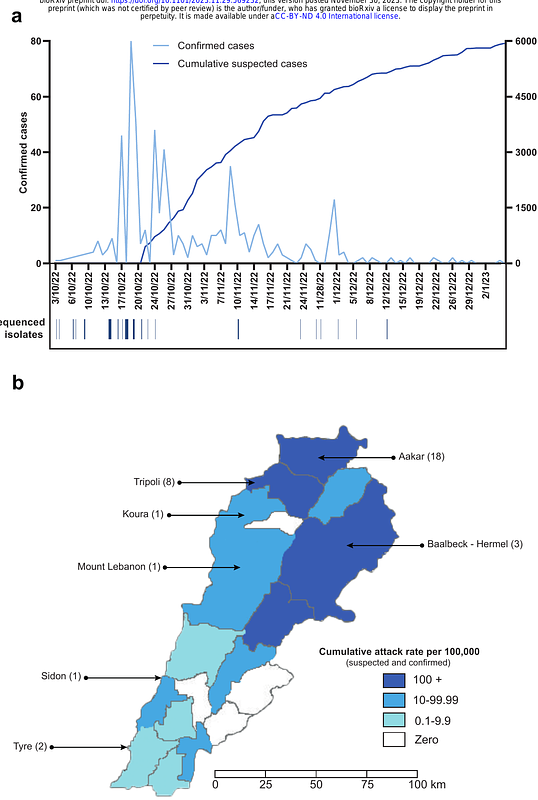An unusual two-strain cholera outbreak in Lebanon, 2022-2023: a genomic epidemiology study

An unusual two-strain cholera outbreak in Lebanon, 2022-2023: a genomic epidemiology study
Abou Fayad, A.; Rafei, R.; Njamkepo, E.; Ezzeddine, J.; Hussein, H.; Sinno, S.; Gerges, J.-R.; Barada, S.; Sleiman, A.; Assi, M.; Baakliny, M.; Hamedeh, L.; Mahfouz, R.; Dabboussi, F.; Feghali, R.; Mohsen, Z.; Rady, A.; Ghosn, N.; Abiad, F.; Abubakar, A.; Barakat, A.; Wauquier, N.; Quilici, M.-L.; Weill, F.-X.; Hamze, M.; Matar, G. M.
AbstractBackground: Cholera is a bacterial infection caused by the ingestion of contaminated water or food. It principally affects the gastrointestinal system and spreads easily, causing outbreaks. The first case of cholera in this outbreak was detected in Lebanon in October 2022. The outbreak lasted three months, with 8,007 suspected cases (671 laboratory-confirmed) and 23 deaths. We characterised the Vibrio cholerae strain responsible for this cholera outbreak. Methods: In total, 34 Vibrio cholerae isolates collected by random sampling of stools, water and plant samples throughout the outbreak and over the affected regions were studied by phenotypic methods and microbial genomics. Findings: All isolates were V. cholerae O1, serotype Ogawa strains from wave 3 of the seventh pandemic El Tor (7PET) lineage. Phylogenomic analysis unexpectedly revealed the presence of two different 7PET strains, a highly unusual finding outside the Bay of Bengal, where several sublineages circulate together. The dominant strain had a narrow antibiotic resistance profile and was phylogenetically related to South Asian V. cholerae isolates. The second strain, which was found exclusively in South Lebanon and Beqaa, was resistant to multiple antibiotics, including macrolides, third-generation cephalosporins and cotrimoxazole. It belonged to the AFR13 sublineage and clustered with V. cholerae isolates collected in Yemen from 2016 to 2019. This second Lebanese strain also harboured the same multidrug-resistance (MDR) IncC-type plasmid found in Yemeni isolates from 2018. Interpretation: The 2022-2023 Lebanese cholera outbreak was caused by the simultaneous introduction of two different 7PET strains. The MDR strain was geographically limited, but the spread of this clone or the horizontal transfer of the MDR plasmid to more susceptible clones could affect epidemic cholera case management. Genomic surveillance is crucial to prevent further spread, and to ensure a prompt and effective response to outbreaks.